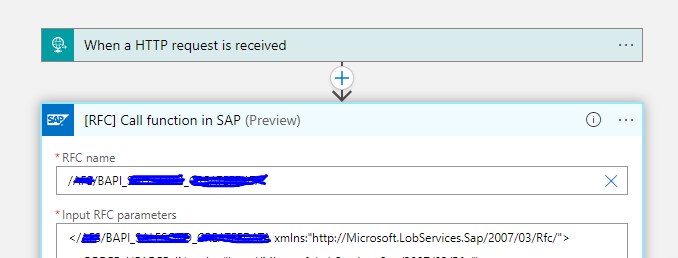The forward-slash character / is reserved in XML for element names. As it is used in SAP for namespace prefixes, it needs to be escaped when used as element name. Your test payload is not a valid XML element name at the moment as it is not escaped.
Here is a dummy XML payload example for RFC named /BDL/ACTIVATE_SDCCN. The root local node name becomes _x002F_BDL_x002F_ACTIVATE_SDCCN. (This example uses explicit ns2 but you can just define the default namespace for root as well and not deal with the namespace prefix).
<?xml version="1.0" encoding="UTF-8"?>
<ns2:_x002F_BDL_x002F_ACTIVATE_SDCCN xmlns:ns2="http://Microsoft.LobServices.Sap/2007/03/Rfc/" xmlns:ns3="http://Microsoft.LobServices.Sap/2007/03/Types/Rfc/" >
<ns2:IF_SOLMAN>X</ns2:IF_SOLMAN>
<ns2:IS_MASTER_RFC>
<ns3:DESTINATION>ns3:DESTINATION</ns3:DESTINATION>
<ns3:INSTALL_NO>00000001</ns3:INSTALL_NO>
<ns3:SID>ns3:SID</ns3:SID>
<ns3:DESCR>ns3:DESCR</ns3:DESCR>
<ns3:MASTER>X</ns3:MASTER>
<ns3:TO_SAP>X</ns3:TO_SAP>
<ns3:USERNAME>ns3:USERNAME</ns3:USERNAME>
<ns3:ACTIVE>X</ns3:ACTIVE>
<ns3:TIMESTAMP>ns3:TIMESTAMP</ns3:TIMESTAMP>
</ns2:IS_MASTER_RFC>
<ns2:ET_MSG>
<ns3:BAPIRET2>
<ns3:TYPE>S</ns3:TYPE>
<ns3:ID>ns3:ID</ns3:ID>
<ns3:NUMBER>000</ns3:NUMBER>
<ns3:MESSAGE>ns3:MESSAGE</ns3:MESSAGE>
<ns3:LOG_NO>ns3:LOG_NO</ns3:LOG_NO>
<ns3:LOG_MSG_NO>000001</ns3:LOG_MSG_NO>
<ns3:MESSAGE_V1>ns3:MESSAGE_V1</ns3:MESSAGE_V1>
<ns3:MESSAGE_V2>ns3:MESSAGE_V2</ns3:MESSAGE_V2>
<ns3:MESSAGE_V3>ns3:MESSAGE_V3</ns3:MESSAGE_V3>
<ns3:MESSAGE_V4>ns3:MESSAGE_V4</ns3:MESSAGE_V4>
<ns3:PARAMETER>ns3:PARAMETER</ns3:PARAMETER>
<ns3:ROW>0</ns3:ROW>
<ns3:FIELD>ns3:FIELD</ns3:FIELD>
<ns3:SYSTEM>ns3:SYSTEM</ns3:SYSTEM>
</ns3:BAPIRET2>
</ns2:ET_MSG>
</ns2:_x002F_BDL_x002F_ACTIVATE_SDCCN>
